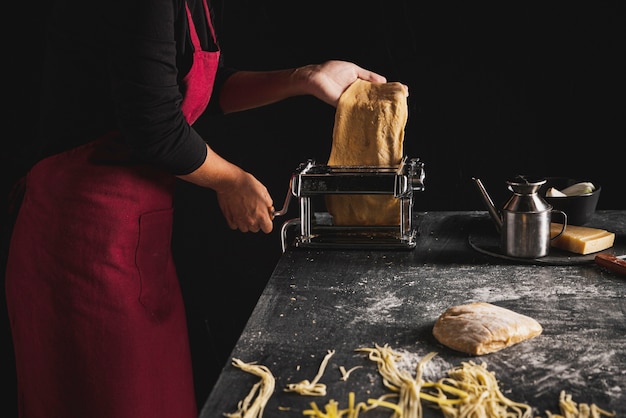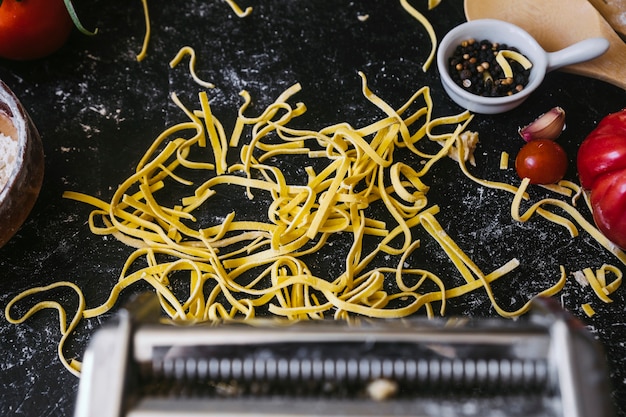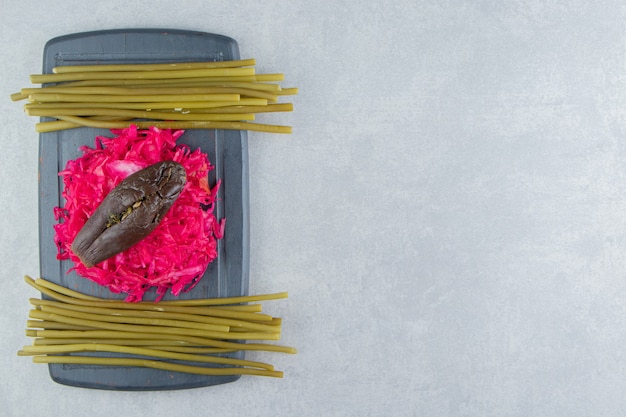There's a certain magic to a perfectly cooked spaghetti dish. The al dente texture, the vibrant sauce clinging to each strand, the comforting aroma wafting through the kitchen – it all adds up to pure pasta bliss. But let’s be real, we’ve all had our pasta mishaps. You know, those moments when your spaghetti turns into a mushy mess or remains stubbornly undercooked, leaving you with a culinary disappointment.
Don’t worry, I’ve been there too, and that’s why I’m here to guide you through the art of cooking spaghetti to perfection. This isn't just about boiling water and tossing in pasta; it’s about understanding the nuances, the little tricks, and the crucial timing that make all the difference.
So grab your apron, grab your favorite pasta pot, and get ready to embark on a journey to spaghetti nirvana!
(Part 1) The Essential Tools: Your Pasta Arsenal

Before we delve into the fascinating world of spaghetti cooking, let's make sure you have the right tools at your disposal. Imagine trying to paint a masterpiece with a dull brush – it’s just not going to happen. Same goes for spaghetti!
Choosing the Right Pot: The Pasta's Playground
Your first order of business is finding a pot that’s spacious enough to accommodate your spaghetti adventure. A good-sized stock pot, with a capacity of at least 8 litres, is ideal. You want plenty of room for the pasta to move freely, ensuring even cooking and preventing any unfortunate sticking incidents.
A Strainer or Colander: The Water Whisperer
Next, you'll need a trusty strainer or colander, ideally large enough to hold all your spaghetti without overflowing. Look for one with fine mesh, to ensure you don’t lose any precious pasta strands as you drain the water.
A Timer: The Keeper of Time
A timer is your pasta companion, keeping track of the cooking time so you don’t have to constantly hover over the pot. Remember, a little bit of attention is good, but too much can disrupt the cooking process.
Tongs or a Serving Spoon: Your Pasta Assistants
You'll need tongs or a serving spoon to effortlessly transfer your cooked spaghetti from the pot to the strainer. These are also handy for gently stirring the pasta during cooking, making sure it doesn't stick together in a pasta-loving embrace.
A Large Bowl: The Sauce-Kissing Station
Finally, a large bowl is essential for tossing your cooked spaghetti with your delicious sauce. Choose one that’s big enough to accommodate all the pasta and sauce, without any messy spills.
(Part 2) The Importance of Water: The Pasta's Elixir
Think of water as the crucial element that transforms your spaghetti from dry strands into a delightful, al dente masterpiece. It’s not just a filler, it’s the pasta’s playground, where it becomes the star of the show.
Using Fresh, Clean Water: A Taste of Purity
Always start with fresh, clean water. I usually opt for filtered water, as I find it gives the pasta a cleaner taste. The water should be cold when you begin, and you’ll need plenty of it.
Water Volume: More is Always Better
One of the most common mistakes is not using enough water. The rule of thumb is to use about 10 litres of water for every 500g of spaghetti. This ensures ample space for the pasta to cook evenly and prevents the water from becoming too starchy.
Salt: The Flavor Enhancer
Adding salt to the water isn’t just about flavour; it also helps the pasta cook more evenly and enhances its natural flavour. Add the salt when the water is boiling – never before.
(Part 3) The Pasta: Choosing Your Perfect Match

Now, the moment of truth – choosing your spaghetti. There are so many types out there, it can be a delicious dilemma.
Choosing the Right Spaghetti: Size Matters
Firstly, consider the size of the spaghetti strands. For a classic spaghetti dish, I usually reach for 5 or 7 spaghetti. These are the classic, standard strands that work beautifully with a variety of sauces. But, for a richer, more substantial flavour, I sometimes opt for 8 or 9 spaghetti, which are slightly thicker and hold their own against bolder sauces.
Fresh vs Dried: A Tale of Two Textures
Then, there’s the choice between fresh and dried spaghetti. Fresh spaghetti, made with durum wheat semolina, is typically more delicate, with a springy texture that cooks faster. Dried spaghetti, on the other hand, boasts a robust flavour and a firmer texture that can withstand longer cooking times.
The Role of Shape and Texture: Beyond the Usual Strand
The shape and texture of the spaghetti also play a role in how it cooks. spaghetti alla chitarra, for instance, is made with a special tool that creates square-shaped strands, giving it a unique bite and a slightly faster cooking time compared to round spaghetti.
(Part 4) The Art of Boiling: Finding the Perfect Bubble

Boiling the water is the pivotal moment, the turning point in your spaghetti journey. The goal is to create a rolling boil, a symphony of bubbles, that ensures the pasta cooks evenly and reaches that perfect al dente texture.
The Importance of a Rolling Boil: A Pasta Symphony
The water needs to be boiling furiously when you add the pasta. This ensures that the pasta cooks evenly, from the outside in, and prevents it from sticking together in a pasta-loving embrace.
Don't Crowd the Pot: Pasta Needs Its Space
Add the pasta to the boiling water gradually, to avoid overcrowding the pot. This keeps the water at a consistent temperature, allowing the pasta to cook properly. Think of it as giving each pasta strand its own personal space to dance in the boiling water.
Stirring the Pasta: The Gentle Touch
Once the pasta is in the pot, stir it gently to prevent it from sticking together. Be sure to stir it a few times during the cooking process, but don’t over-stir it, as this can break the pasta.
(Part 5) Timing is Everything: The Pasta Countdown
This is where your timer becomes your trusted companion. The time it takes for your spaghetti to reach that perfect al dente state will vary depending on the type of pasta, the size of the strands, and the temperature of the water.
Reading the Packaging: A Guide to Timing
The first step is to always check the instructions on the packaging. Each brand of spaghetti has its own recommended cooking time, which serves as a good starting point.
The Al Dente Test: Mastering the Bite
The al dente test is the ultimate way to determine if your spaghetti is cooked perfectly. Take a single strand of pasta and bite into it. If it’s firm to the bite, but not hard or chewy, then it’s al dente. If it’s soft and mushy, then it’s overcooked.
Adjusting the Timing: The Art of Observation
The cooking time on the packet is just a guide. You may need to adjust it slightly depending on the size of your pot, the amount of water you are using, and the type of pasta you are cooking.
(Part 6) The Drain: A Gentle Farewell to Water
Once your spaghetti is al dente, it's time for a gentle goodbye to the water. This step is crucial because it can affect the final texture of your pasta.
The Right Drainage Technique: Preserve the Texture
When draining the spaghetti, don’t simply pour the water out of the pot. Instead, use a strainer or colander to lift the pasta out of the water. This helps to preserve the pasta’s texture, preventing it from sticking together and becoming mushy.
Saving the pasta water: A Starchy Treasure
Here’s a little chef secret: save some of the pasta water! This starchy water, called “pasta water,” is a treasure trove of flavor. You can use it to thin out your sauce and add an extra layer of richness to your dish.
(Part 7) The Sauce: A Love Story in Flavour
The sauce is where your spaghetti journey truly blossoms. It’s the love story that completes the dish, adding a burst of flavor and transforming your al dente masterpiece.
Choosing the Right Sauce: A Personal Touch
The sauce you choose will depend on your personal preferences and the occasion. A classic tomato sauce, with its vibrant acidity, is always a crowd-pleaser, while a creamy pesto sauce offers a fragrant and earthy delight. A spicy arrabbiata sauce adds a fiery kick, and a rich carbonara sauce is a creamy indulgence. The options are endless, so let your palate be your guide.
The Sauce Toss: A Final Embrace
Once your sauce is ready, toss the spaghetti with it in the large bowl you prepared earlier. Be generous with the sauce, and don’t be afraid to add some of that reserved pasta water to help the sauce cling to the spaghetti and create a symphony of flavour.
Garnish with Love: The Finishing Touches
Finally, add a touch of culinary magic with a garnish. A sprinkle of parmesan cheese adds a salty and nutty flavour, while fresh basil adds a vibrant, herbaceous touch. A drizzle of olive oil adds a touch of richness and elegance. These finishing touches are the final notes in your spaghetti symphony.
(Part 8) Serving with Style: The Perfect Plate
You’ve followed every step, your spaghetti is cooked to perfection, and the sauce is singing with flavour. Now it's time to present your culinary masterpiece with style.
The Serving Platter: A Stage for Your Pasta
Choose a serving platter that’s large enough to showcase your spaghetti. A simple white platter allows the vibrant colours of your dish to shine, while a rustic wooden platter adds a touch of warmth and charm.
Plating with Purpose: A Visual Symphony
When plating your spaghetti, don’t simply pile it on the plate. Instead, create a visually appealing presentation. Arrange the spaghetti in a mound, or spread it out in a fan shape. Use the sauce to create a swirl of colour, and add your garnish as a final flourish.
Sharing is Caring: A Pasta Feast
If you’re sharing your spaghetti, then you can use individual plates or pasta bowls. Serve your spaghetti hot and fresh, and allow the aromas to fill the air, inviting everyone to savor each bite.
FAQs: Pasta Wisdom Answered
Here are some common questions about cooking spaghetti, answered from my pasta-loving heart:
1. What happens if I overcook my spaghetti?
Overcooked spaghetti will be soft and mushy, losing its texture and vibrant flavour. It’ll become a pale imitation of its al dente self. If you accidentally overcook your spaghetti, you can try adding a generous amount of sauce and cheese to mask the texture, but it won’t be the same.
2. How can I tell if my spaghetti is al dente?
The al dente test is the best way to determine if your spaghetti is cooked properly. Take a single strand of pasta and bite into it. It should be firm to the bite, but not hard or chewy. The key is to have a slight resistance, like a gentle bite back.
3. What if I don’t have a strainer?
If you don’t have a strainer, you can use a colander to drain your spaghetti. Just make sure it’s large enough to hold all the pasta, and ensure the holes are small enough to prevent any pasta strands from escaping.
4. What can I do with leftover spaghetti?
Leftover spaghetti can be used to create a variety of delicious dishes. You can toss it with a new sauce, like a pesto or a creamy alfredo sauce, or add it to a soup or salad for a burst of flavour and texture.
5. Can I cook spaghetti in the microwave?
It’s not recommended to cook spaghetti in the microwave. You won’t achieve the same even cooking and texture as you would on the stovetop. The microwave method can lead to uneven cooking, resulting in some parts being overcooked while others remain undercooked.
The Final Bite: A Pasta Passion
Cooking spaghetti is a culinary adventure, a journey that leads to pure pasta bliss. I encourage you to experiment, embrace the process, and enjoy the symphony of flavours that spaghetti brings to your table. Remember, the key is to have fun, discover your own unique pasta passion, and create dishes that truly delight your palate!
Everyone is watching

How to Cook Frozen Lobster Tails Perfectly: A Step-by-Step Guide
RecipesLobster. Just the word conjures up images of lavish meals, special occasions, and a taste of luxury. But let's...

Pigs in a Blanket Cooking Time: How Long to Bake for Perfect Results
RecipesAh, pigs in a blanket. Just the name conjures up images of those delightful little parcels of crispy pastry en...

Pork Fillet Cooking Time: How Long to Cook It Perfectly
RecipesPork fillet, or tenderloin as it's sometimes called, is a real favourite in our house. It's so versatile, and...

The Ultimate Guide to Cooking Delicious Frankfurters
RecipesLet's face it, we all love a good frankfurter. It's a classic, simple, and always satisfying. But let's be rea...

The Ultimate Guide to Tender, Juicy Pulled Pork
RecipesRight, let's talk pulled pork. It's one of those dishes that just screams "comfort food," doesn't it? I mean...
